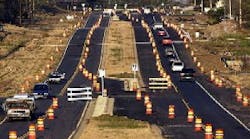“Red-hot steel prices, combined with record diesel fuel costs, are making construction unaffordable.” --Ken Simonson, chief economist for the Associated General Contractors of America
As I‘ve said in this space before, our surface road network is in dire need of a big makeover and expansion effort. Any trucker can tell you that. The problem now is that the cost to repair the roads - much less build new ones - is skyrocketing spaceward at a rapid clip. That means just when we desperately need to start fixing our highway infrastructure, our tax dollars won‘t go nearly as far as they‘ve done in past years.
“The PPI [producer price index] for inputs to construction industries - materials used in all types of construction plus items consumed by contractors, such as diesel fuel - soared 2.1% in March alone,” said Ken Simonson, chief economist for the Associated General Contractors of America (AGC). “That jump was propelled by a staggering 24% increase in diesel fuel costs and a 5.5% rise in prices for steel mill products.”
(Photo courtesy of P.B. Laminators Inc.)
“Unfortunately, there is worse to come,” he added. “Steel suppliers have been burning up the wires announcing huge price increases and canceling previous quotes. And the Energy Information Administration reported last night that the average price of highway diesel crossed the $4 per gallon mark in all regions for the first time, with a 10-cent increase in the national average just in the past week, to $4.05 per gallon. These figures won‘t show up in the producer price index until next month, but contractors are paying them now.”
All this at a time when the Highway Trust Fund is going broke and transportation infrastructure funding is way, way off from where it needs to be.
More than half of U.S. urban interstates are now congested, according to research compiled by the HNTB Companies, and it‘s projected that next year federal Highway Trust Fund revenues will no longer be sufficient to fully fund planned federal transportation spending.
Also, according to the National Surface Transportation Policy and Revenue Study Commission published earlier this year, all levels of government in the U.S. are spending less than 40% of the $225 billion to $340 billion needed for highway upkeep. As one HNTB employee commented in the survey, “Not all funding can be spent on new facilities while existing facilities are in poor shape and functionally obsolete.”
(Photo courtesy of the Las Veags Review Journal.)
Legislation was introduced recently in the U.S. Senate to create an agency and a National Infrastructure Bank to facilitate and fund large federal projects, with a preference for those that leverage private financing and public-private partnerships. Problem is, with costs spiraling upwards so fast, those federal dollars won‘t go nearly as far as they need to.
“Public agencies as well as private owners need to adjust to these realities,” said AGC‘s Simonson. “Too many of them are still assuming construction costs are rising no faster than the consumer price index (CPI), when in fact the PPI for construction inputs has gone up 6.5% in the past 12 months and 34% since steel prices first surged in December 2003. That is more than double the run-up in the CPI.”
He added that diesel prices are now more than 60 cents a gallon higher than the $3.44 average price for gasoline, putting a triple burden on contractors that use diesel to power off-road equipment and construction trucks, along with fuel surcharges on the thousands of deliveries and backhauls at a large job site.
“As the highway paving season gets under way, asphalt prices also are poised to take off,” Simonson concluded. “Asphalt at the refinery cost 13% more in March than a year ago. But many states and the federal government are running low on highway funds because motorists and truckers have been driving less.”
(This kinda says it all, doesn't it? Photo courtesy of Eric Siegmund.)
Needless to say, the cost hurdles are getting higher and harder to overcome where transportation infrastructure construction is concerned, so we‘re going to need some sharp thinking in the days and years ahead to overcome them.



